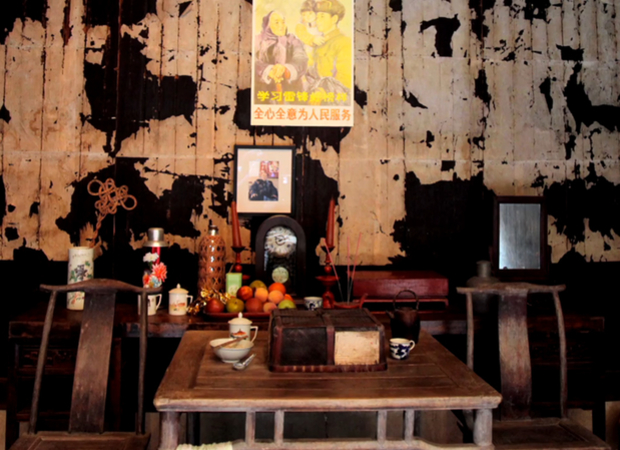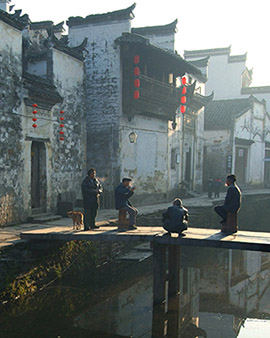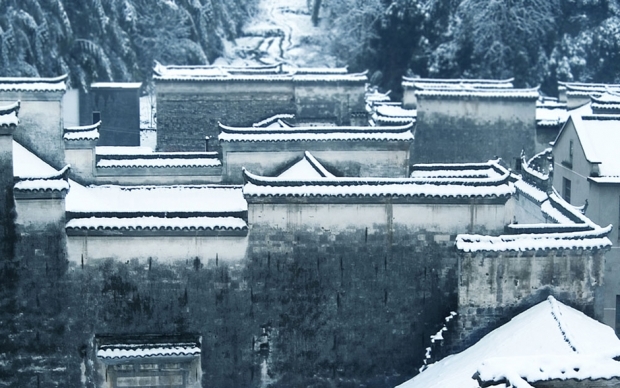When, in 1996, art historian Nancy Berliner purchased a late Qing dynasty merchants’ house from Huangcun, a village in Anhui province, it was just one ordinary house among thousands like it in the picturesque Huizhou region of China. It took Berliner seven years to oversee the meticulous process of dismantling and shipping the house, called Yin Yu Tang, and then re-erecting it at the Peabody Essex museum in Salem, Massachusetts. A decade has passed since it was opened to the American public in 2003. Now the crown jewel of the museum, it is widely considered in both the United States and China to be a rare successful example of preserving a historic building by moving it from the spot where it first stood. But today a growing interest in collecting traditional architecture in China has thrown a spotlight on the practice called yidi baohu, “preservation through relocation.”
Even as China’s fastest growing cities bulldoze their old neighborhoods to make way for shiny new skyscrapers, historic homes like those in Huizhou have become trophies for a new, aggressively acquisitive class of Chinese collectors. It is hard to say precisely how many of these houses have been removed from the Huizhou region. But the trend is clear. Zhang Jianping, a local photographer who has been photographing Huizhou for twenty-six years, recently told Anhui Television that, “in the past seven years, the historic houses have been disappearing from Huizhou villages at an unimaginable speed.” In most Huizhou villages, only a handful of the oldest houses, ancestral halls, theaters, temples, and objects are subject to protection as “cultural relics.” And even these can go missing. In 2013, the Anhui Cultural Relics Management Bureau reported that 2,134 relics had disappeared in the past five years. Often, the general public only learns that buildings have been moved when they reemerge in faraway cities. In early April, for example, action movie star Jackie Chan announced a plan to ship four Huizhou buildings in his collection to Singapore.
The mountainous Huizhou region, which lies around 250 miles southwest of Shanghai, historically covered five counties in today’s Anhui province and one county in Jiangxi province. It first became prosperous during the Southern Song Dynasty (1127-1279), supplying bamboo, wood, and lacquer to Hangzhou, the nearby imperial capital. Over the following 600 years, Huizhou merchants flourished and eventually dominated commerce in timber, salt, ink, tea, porcelain, and pawnshops throughout China. During its heyday—from the 16th to 18th centuries—the region boasted fine Confucian private schools and skilled craftsmen, and supplied large numbers of scholar-officials to the imperial government. Literature and opera flourished, as did architectural innovation. Beginning in the 19th century, however, the region’s prosperity was impaired severely, first by the Taiping Rebellion and then by a century of war and revolution. By the end of the Cultural Revolution in 1976, the centuries-old tradition of private business and the lineage and kinship organizations at its foundation, had been wiped out. In 2012, Anhui’s per capita GDP ranked 26th among China’s thirty-one provinces and municipalities, although its neighbors—Jiangsu and Zhejiang—ranked as two of the nation’s richest provinces.
Earthbound China
04.11.13
Moving House: Preserving Huizhou’s Vernacular Architecture
Huizhou residents began migrating in large numbers to nearby cities to look for economic opportunities in the 1990s. Their urban experience soon influenced their housing preferences. The old houses—with their constant courtyard drafts, damp floors, and lack of plumbing—had lost their charm. Villagers now wanted houses with big windows, tile floors, and modern amenities. The Yin Yu Tang project and the designation of the Huizhou towns of Xidi and Hongcun as UNESCO World Heritage Sites in 2000 increased people’s awareness of the cultural tourism value of the region’s historic homes. But for locals, maintaining and repairing the houses remained a huge financial burden in a region where, as recently as 2012, annual per capita income was only $2,420. The poverty of the region left the traditional houses of Huizhou quite vulnerable.
Starting in the late 1990s, demand from private collectors gave rise to a cottage industry in disassembling, transporting, and rebuilding the last vestiges of China’s historic architecture. Preservation and conservation experts generally only consider moving a historic building as a last resort. But in China, the relocation of these houses has become the norm rather than an exception. In the case of Yin Yu Tang, the Peabody Essex Museum not only preserved the house (and everything inside) exactly as it was when it was last occupied in the 1980s, but also built an extensive multimedia archive recording the history of the building, the family that lived there, and the traditions of the village around them. In stark contrast, most historic homes relocated in China are rebuilt with little attention to their design or to their history. Collectors’ interest in these houses suggests they appreciate traditional architectural motifs. But when they move the houses, they sever their connection to the places where they belong. Far from their original foundations, the houses become mere beautiful objects, and the region is stripped of important links to its history and identity.
Wendao Garden, a recreational park featuring twelve Huizhou houses, opened in Shanghai in 2010. According to an October 2011 article published in the Shanghai daily newspaper Wen Hui Bao, Wang Wei, the owner of the park, had acquired more than fifty houses, three memorial arches, six pavilions, and two bridges from the Huizhou region since 2002. Most still sat in his warehouse, waiting to be reassembled. In 2001, Hengdian World Studios in Zhejiang province—China’s, and the world’s, largest film studio—began acquiring 120 Ming and Qing dynasty buildings, many from Huizhou, rebuilding them in its gigantic compound.
In comparison to the razed hutongs and courtyard houses of Beijing, relocated Huizhou homes can seem to have fared relatively well. Indeed, until recently, cases of preservation through relocation met with nearly unanimous praise in Chinese media. But as these symbols of Huizhou culture increasingly are admired in bigger cities, there also is a growing group of urban people with familial ties to Huizhou, whose regional pride has motivated them to become advocates for keeping the buildings in their original locations. In June 2011, the Ministry of Culture and the Anhui provincial government passed regulations prohibiting the relocation of historical houses to areas outside Huizhou. But the collecting fever is not likely to be curbed overnight. Even after the regulations took effect, the contemporary architecture magazine Mark reported in December 2011 that Shanghai Jiaotong University had purchased fifteen Huizhou houses, moved them to its campus, and was working on plans to buy fifteen more.

In the past year, relics experts have become increasingly vocal about their concerns over the relocation of historic buildings, generating a rise in coverage of the problem in the Chinese media. Last December, Tan Yufeng, Deputy Chief Engineer of the Shanghai Municipal Bureau of Cultural Relics, told the Chinese magazine Caixin: “The optimal way to preserve cultural relics is to preserve them in their original location. The value of cultural relics lies in their countless connections with their immediate surroundings. Only when keeping these relics in their original location would result in negative impacts on the region should we consider preservation through relocation.”
During a public hearing in January 2013, Guangzhou Mayor Chen Jianhua approved a property developer’s proposal to build an architectural museum with seven Ming dynasty houses relocated from the provinces of Anhui and Shanxi. Chen told reporters that he personally “is against the practice of preservation through relocation, but since these houses have already been in storage in Guangzhou for several years, it serves the public interest to restore them as faithfully as possible to their original design and open them to the public for free.”
On April 4, Jackie Chan announced on Sina Weibo, a Chinese microblogging website, that he had kept ten Huizhou structures in storage for the past twenty years. He said that originally he had intended to build a large Chinese garden for his parents who preferred traditional Chinese living, but that they had passed away before construction began. For the past ten years Chan was looking for a new home for his collection. Last year, he finally settled upon the Singapore University of Technology and Design.
On Weibo, thousands of people expressed frustration that the buildings will be leaving China. Weibo user @Lee-虎究 wrote: “I wish Jackie Chan could donate these houses back to the Huizhou people. They house our cultural heritage. Whatever cultural and educational functions they can serve in Singapore would be better served if they stay in Huizhou.” Many others supported Chan’s decision. Weibo user @Star晓辉 said: “If kept in Anhui, these buildings would either be devoured by termites under the negligent watch of the relevant department or demolished to make way for ‘Modernization.’ I’d say it’s better to give them to someone who really cares about them.”
Back in Huangcun, a pale blue-tiled modern house now occupies the lot where Yin Yu Tang used to stand. Since Yin Yu Tang’s departure, Berliner has worked with the local government to keep the rest of Huangcun’s historical buildings intact. For years, the local government has been trying to purchase the land-use rights to rebuild Yin Yu Tang in its original location, but is unable to agree on a settlement with the owner of the modern house. It might sound like an absurd idea, but Zuo Jing, a Huizhou preservationist and the co-founder of the Bishan Commune, a local rural development organization, explained that rebuilding Yin Yu Tang in Huangcun not only would have important symbolic meaning to the Huizhou people, but also could serve as an experiment with practical implications: “What if architects from around the world could be invited to conceptualize a new design for Yin Yu Tang, a sustainable design that respects both the wonderful tradition of Huizhou architecture and local residents’ modern needs?”




